Gatsby Grange: Accounting Ratios, Financial Analysis, and Hospitality
VerifiedAdded on 2023/01/10
|18
|3388
|65
Report
AI Summary
This report analyzes the financial performance of Gatsby Grange, a small boutique hotel chain in the UK and Northern Ireland, using accounting ratios. It examines solvency, turnover, and profitability ratios for the years 2018 and 2019, evaluating their benefits and limitations within the hospitality industry. The analysis includes calculations of current and quick ratios, fixed and current asset turnover ratios, and gross and net profit ratios. The report explores how these ratios inform financial decision-making, strategic planning, and competitive positioning within the market. It also highlights the importance of financial management concepts such as net profit, final accounts, and cash flow statements for understanding a company's current standing in a competitive market. The report concludes with recommendations based on the financial analysis and emphasizes the significance of minimizing expenditure and maximizing profit margins to ensure long-term sustainability and competitiveness.
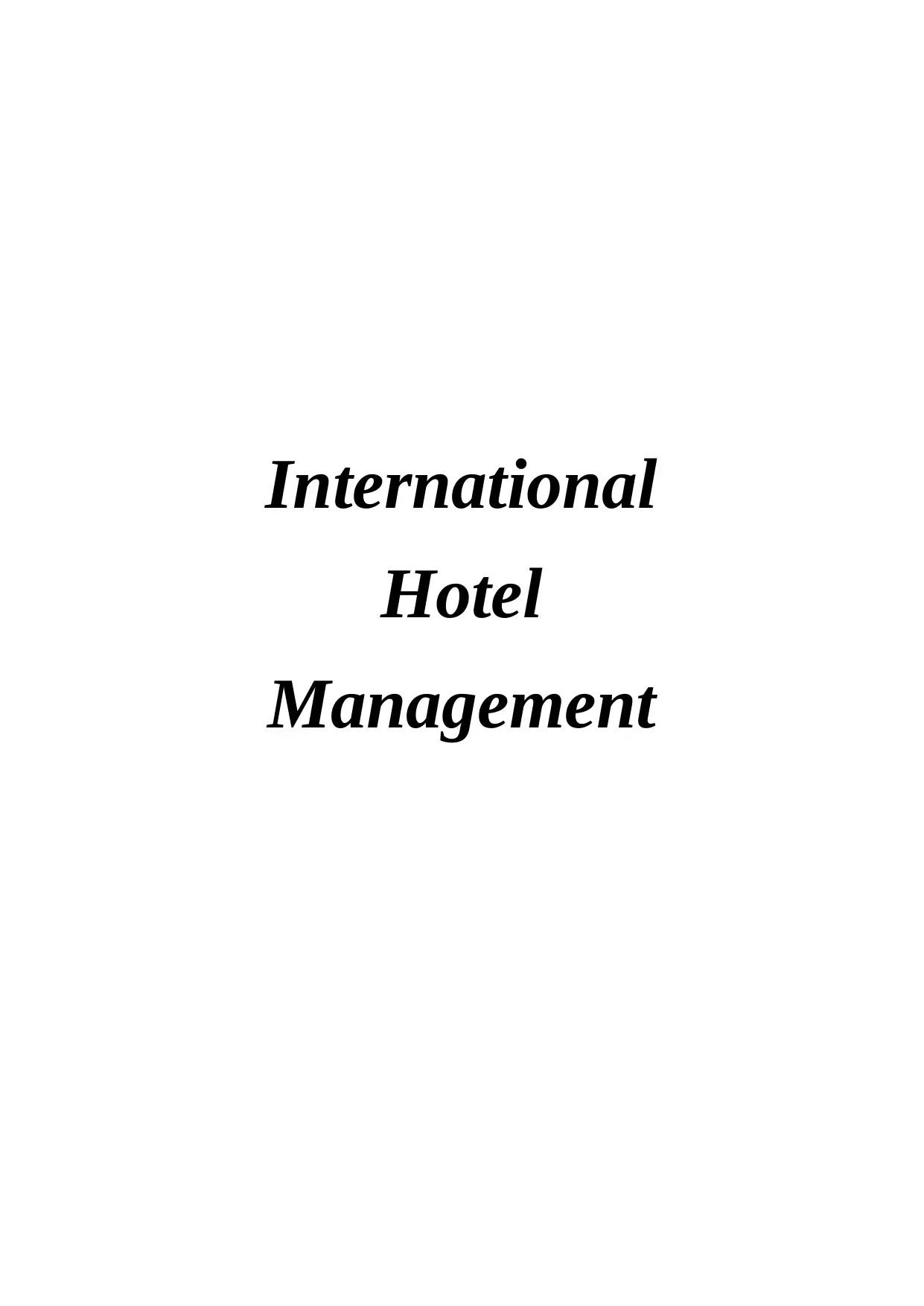
International
Hotel
Management
Hotel
Management
Paraphrase This Document
Need a fresh take? Get an instant paraphrase of this document with our AI Paraphraser
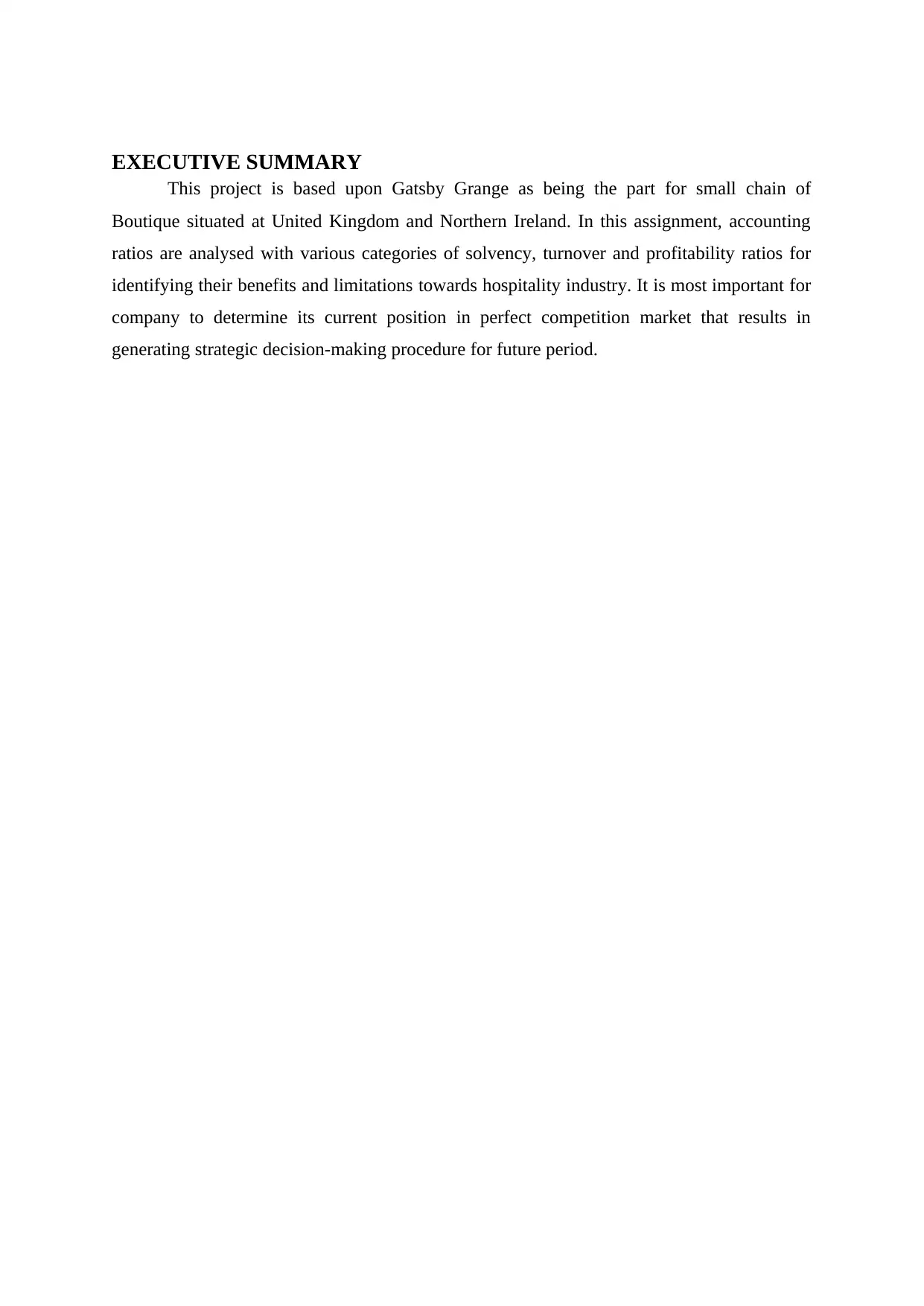
EXECUTIVE SUMMARY
This project is based upon Gatsby Grange as being the part for small chain of
Boutique situated at United Kingdom and Northern Ireland. In this assignment, accounting
ratios are analysed with various categories of solvency, turnover and profitability ratios for
identifying their benefits and limitations towards hospitality industry. It is most important for
company to determine its current position in perfect competition market that results in
generating strategic decision-making procedure for future period.
This project is based upon Gatsby Grange as being the part for small chain of
Boutique situated at United Kingdom and Northern Ireland. In this assignment, accounting
ratios are analysed with various categories of solvency, turnover and profitability ratios for
identifying their benefits and limitations towards hospitality industry. It is most important for
company to determine its current position in perfect competition market that results in
generating strategic decision-making procedure for future period.
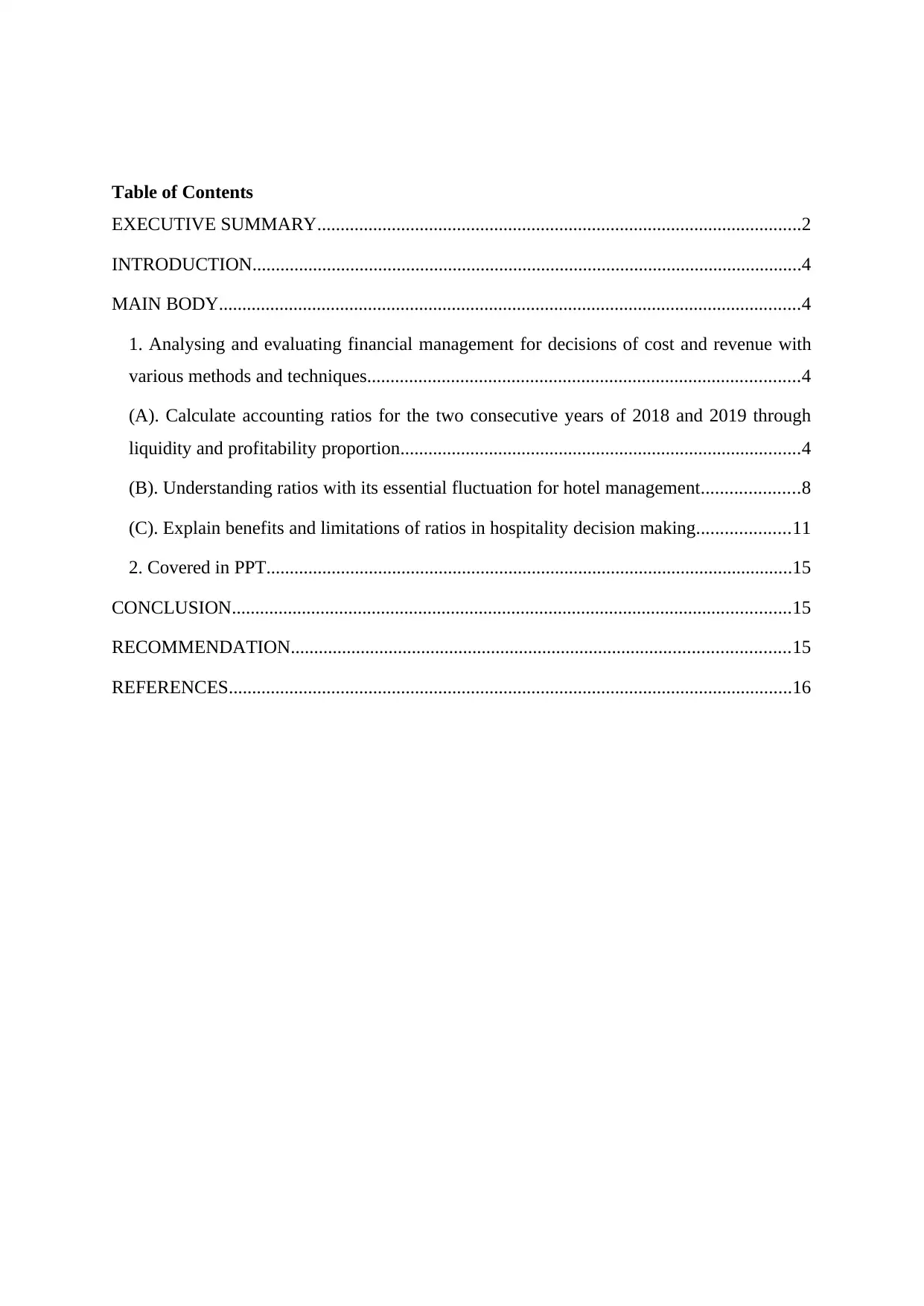
Table of Contents
EXECUTIVE SUMMARY........................................................................................................2
INTRODUCTION......................................................................................................................4
MAIN BODY.............................................................................................................................4
1. Analysing and evaluating financial management for decisions of cost and revenue with
various methods and techniques.............................................................................................4
(A). Calculate accounting ratios for the two consecutive years of 2018 and 2019 through
liquidity and profitability proportion......................................................................................4
(B). Understanding ratios with its essential fluctuation for hotel management.....................8
(C). Explain benefits and limitations of ratios in hospitality decision making....................11
2. Covered in PPT.................................................................................................................15
CONCLUSION........................................................................................................................15
RECOMMENDATION...........................................................................................................15
REFERENCES.........................................................................................................................16
EXECUTIVE SUMMARY........................................................................................................2
INTRODUCTION......................................................................................................................4
MAIN BODY.............................................................................................................................4
1. Analysing and evaluating financial management for decisions of cost and revenue with
various methods and techniques.............................................................................................4
(A). Calculate accounting ratios for the two consecutive years of 2018 and 2019 through
liquidity and profitability proportion......................................................................................4
(B). Understanding ratios with its essential fluctuation for hotel management.....................8
(C). Explain benefits and limitations of ratios in hospitality decision making....................11
2. Covered in PPT.................................................................................................................15
CONCLUSION........................................................................................................................15
RECOMMENDATION...........................................................................................................15
REFERENCES.........................................................................................................................16
⊘ This is a preview!⊘
Do you want full access?
Subscribe today to unlock all pages.

Trusted by 1+ million students worldwide
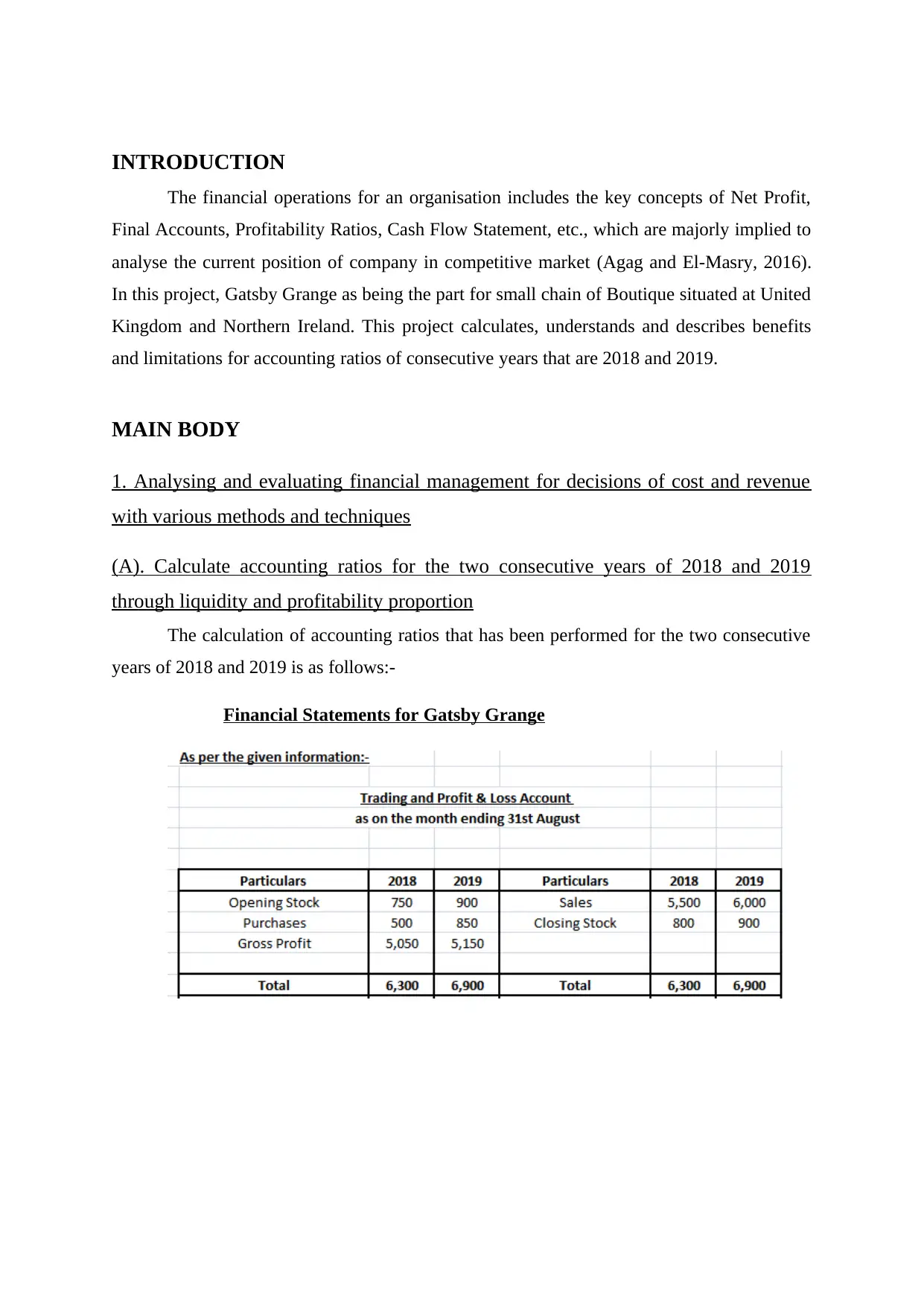
INTRODUCTION
The financial operations for an organisation includes the key concepts of Net Profit,
Final Accounts, Profitability Ratios, Cash Flow Statement, etc., which are majorly implied to
analyse the current position of company in competitive market (Agag and El-Masry, 2016).
In this project, Gatsby Grange as being the part for small chain of Boutique situated at United
Kingdom and Northern Ireland. This project calculates, understands and describes benefits
and limitations for accounting ratios of consecutive years that are 2018 and 2019.
MAIN BODY
1. Analysing and evaluating financial management for decisions of cost and revenue
with various methods and techniques
(A). Calculate accounting ratios for the two consecutive years of 2018 and 2019
through liquidity and profitability proportion
The calculation of accounting ratios that has been performed for the two consecutive
years of 2018 and 2019 is as follows:-
Financial Statements for Gatsby Grange
The financial operations for an organisation includes the key concepts of Net Profit,
Final Accounts, Profitability Ratios, Cash Flow Statement, etc., which are majorly implied to
analyse the current position of company in competitive market (Agag and El-Masry, 2016).
In this project, Gatsby Grange as being the part for small chain of Boutique situated at United
Kingdom and Northern Ireland. This project calculates, understands and describes benefits
and limitations for accounting ratios of consecutive years that are 2018 and 2019.
MAIN BODY
1. Analysing and evaluating financial management for decisions of cost and revenue
with various methods and techniques
(A). Calculate accounting ratios for the two consecutive years of 2018 and 2019
through liquidity and profitability proportion
The calculation of accounting ratios that has been performed for the two consecutive
years of 2018 and 2019 is as follows:-
Financial Statements for Gatsby Grange
Paraphrase This Document
Need a fresh take? Get an instant paraphrase of this document with our AI Paraphraser
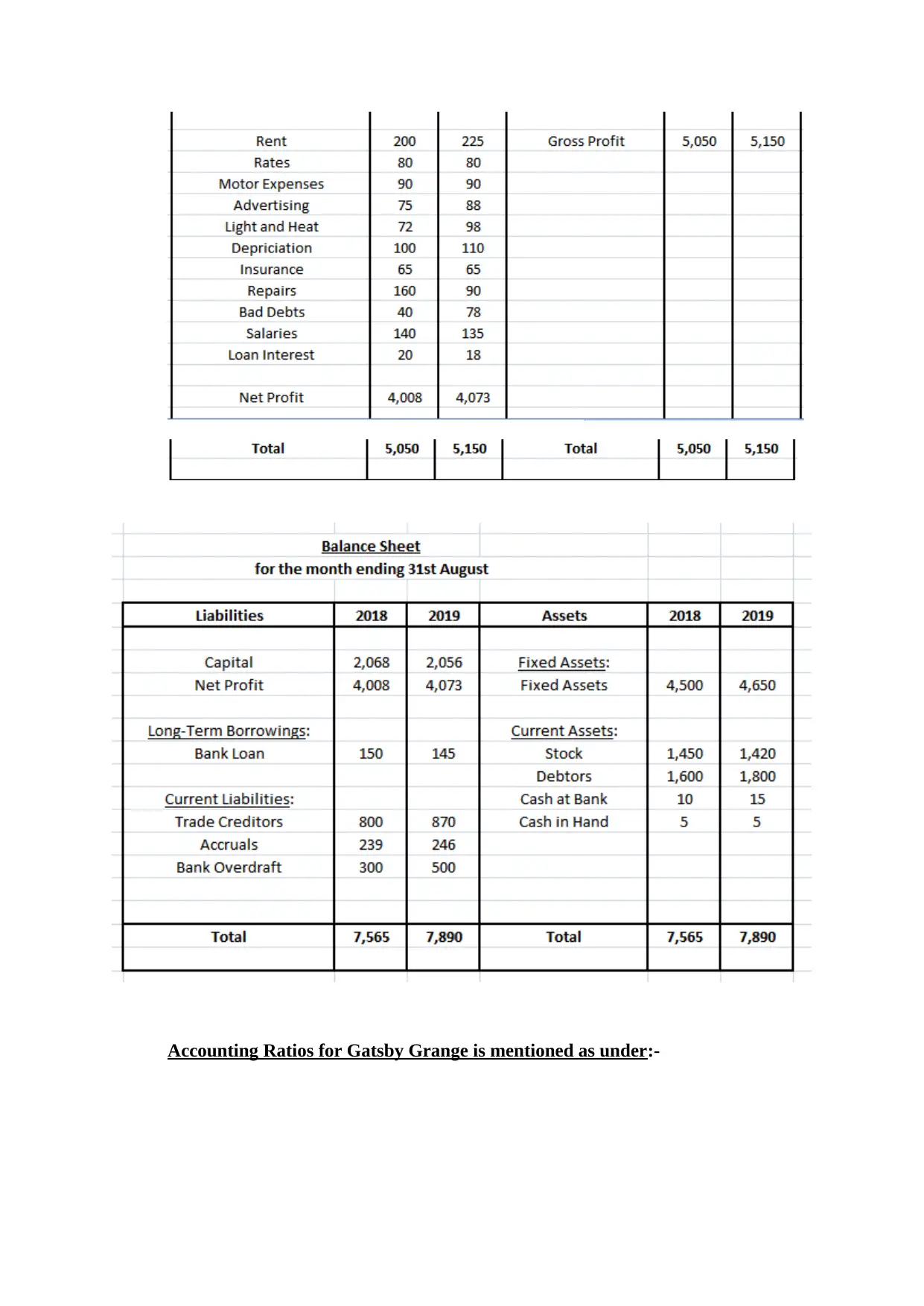
Accounting Ratios for Gatsby Grange is mentioned as under:-

⊘ This is a preview!⊘
Do you want full access?
Subscribe today to unlock all pages.

Trusted by 1+ million students worldwide
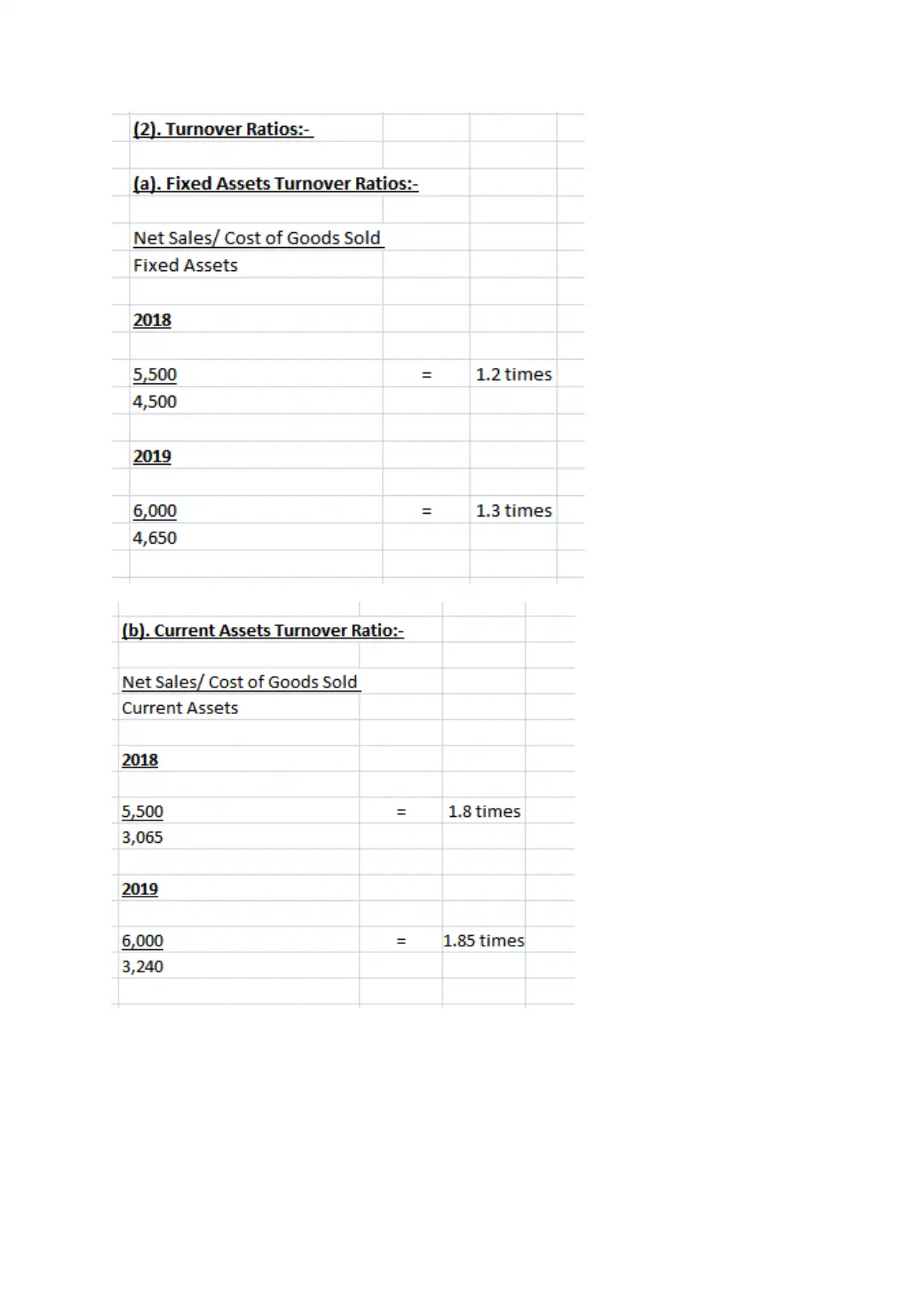
Paraphrase This Document
Need a fresh take? Get an instant paraphrase of this document with our AI Paraphraser
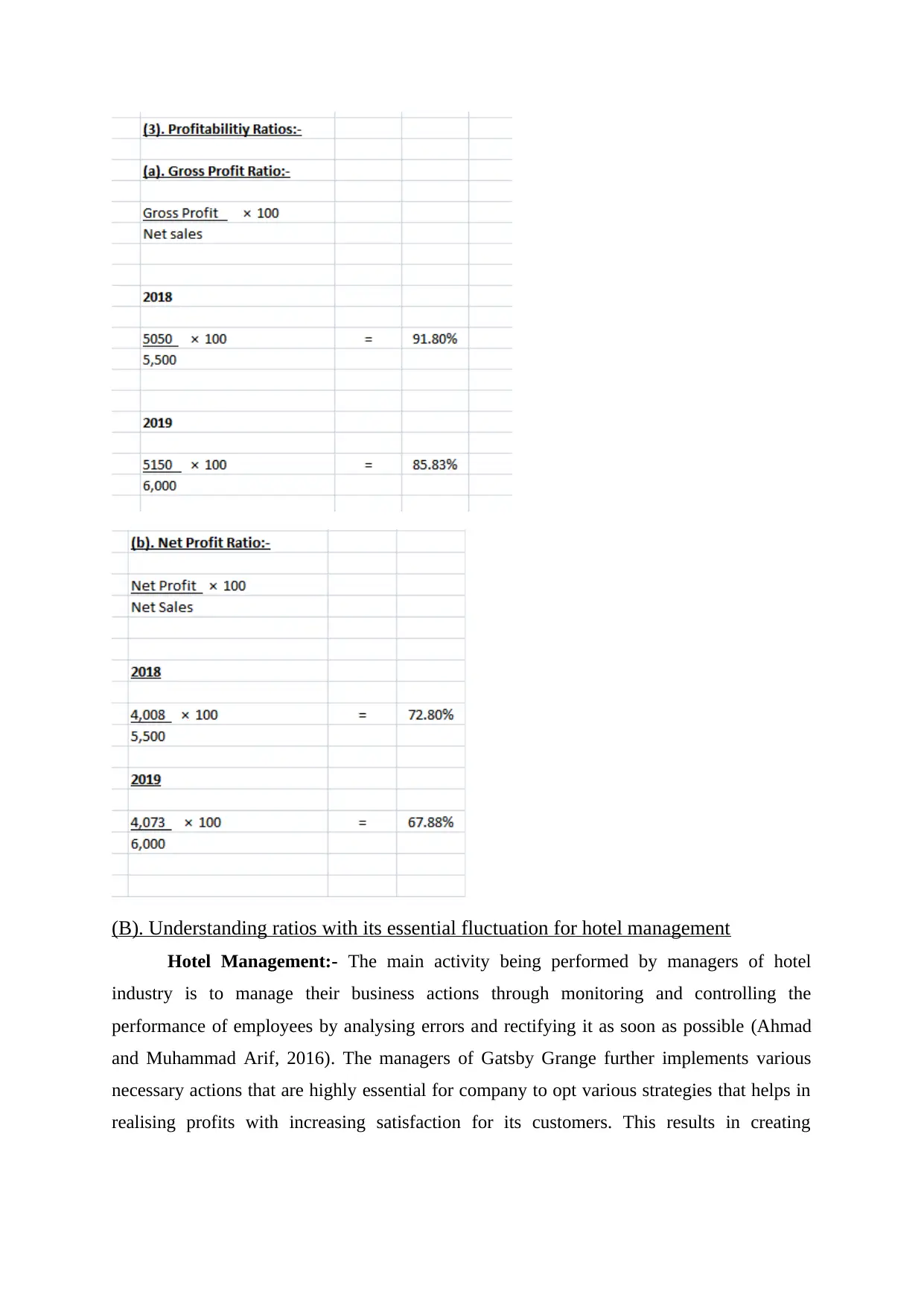
(B). Understanding ratios with its essential fluctuation for hotel management
Hotel Management:- The main activity being performed by managers of hotel
industry is to manage their business actions through monitoring and controlling the
performance of employees by analysing errors and rectifying it as soon as possible (Ahmad
and Muhammad Arif, 2016). The managers of Gatsby Grange further implements various
necessary actions that are highly essential for company to opt various strategies that helps in
realising profits with increasing satisfaction for its customers. This results in creating
Hotel Management:- The main activity being performed by managers of hotel
industry is to manage their business actions through monitoring and controlling the
performance of employees by analysing errors and rectifying it as soon as possible (Ahmad
and Muhammad Arif, 2016). The managers of Gatsby Grange further implements various
necessary actions that are highly essential for company to opt various strategies that helps in
realising profits with increasing satisfaction for its customers. This results in creating

aggressive strategies by affecting the strategic decision making procedures of its opponents
through transforming their loyal customers into our clients with extra facilities at low cost.
Accounting Ratios:- The accounting ratios are most essential for hospitality industry
as it plays major role in identifying the current statistics for analysing the favourable and
unfavourable position of company. These accounting ratios are further categorised into three
main categories as mentioned above are solvency, turnover and profitability ratios. The
managers of Gatsby Grange further aims to implement these accounting ratios within their
organisation for identifying the comparison among previous and current year as well as to
differentiate with its rivalries. It is most esteemed calculation being done by stakeholders for
determining the strength and flexibility of profitability at financial status.
Solvency Ratios:- The solvency ratios is described as most important tool being
applied by an organisation for minimising its long-term debentures. These ratios are
further classified as current, quick, debt to equity and interest coverage ratios. The
managers of Gatsby Grange implement these ratios for measuring the ability of
company to meet its long-term debts with identification of taxable income, non-
operating expenses, etc.
(a) Current Ratio:- This is defined as the ability of relationship between current
assets and liabilities that consists of ideal working capital ratio of 2:1. It is most
important for organisation in generating high current ratio that has the capability
to minimise current liabilities (Barreda and et.al., 2017). Managers of Gatsby
Grange are highly facilitated with their increasing current ratios in both years
through 2.29:1 at 2018 and 2:1 at 2019. This represents the highest ideal ratio for
company stability at global marketplace.
(b) Quick Ratio:- The Liquid/ Quick Ratio is described as to calculate the quick
assets by excluding inventory and prepaid expenses. Its ideal ratio is 1:1 as being
described for idyllic model that evaluates the financial position of company is in
sound nature. The managers of Gatsby Grange implement this ratio for paying off
current debt obligations without increasing capital generation. The company is
highly profitable with its quick ratio in both years which is represented as 1.20:1
at 2018 and 1.13:1 at 2019.
Turnover Ratios:- The turnover ratios are also termed as financial ratios. It is mostly
used organisation for identifying their assets in respect to annual income within the
same year (Bharathi and Rajapushpam, 2017). This ratio describes the effectiveness
through transforming their loyal customers into our clients with extra facilities at low cost.
Accounting Ratios:- The accounting ratios are most essential for hospitality industry
as it plays major role in identifying the current statistics for analysing the favourable and
unfavourable position of company. These accounting ratios are further categorised into three
main categories as mentioned above are solvency, turnover and profitability ratios. The
managers of Gatsby Grange further aims to implement these accounting ratios within their
organisation for identifying the comparison among previous and current year as well as to
differentiate with its rivalries. It is most esteemed calculation being done by stakeholders for
determining the strength and flexibility of profitability at financial status.
Solvency Ratios:- The solvency ratios is described as most important tool being
applied by an organisation for minimising its long-term debentures. These ratios are
further classified as current, quick, debt to equity and interest coverage ratios. The
managers of Gatsby Grange implement these ratios for measuring the ability of
company to meet its long-term debts with identification of taxable income, non-
operating expenses, etc.
(a) Current Ratio:- This is defined as the ability of relationship between current
assets and liabilities that consists of ideal working capital ratio of 2:1. It is most
important for organisation in generating high current ratio that has the capability
to minimise current liabilities (Barreda and et.al., 2017). Managers of Gatsby
Grange are highly facilitated with their increasing current ratios in both years
through 2.29:1 at 2018 and 2:1 at 2019. This represents the highest ideal ratio for
company stability at global marketplace.
(b) Quick Ratio:- The Liquid/ Quick Ratio is described as to calculate the quick
assets by excluding inventory and prepaid expenses. Its ideal ratio is 1:1 as being
described for idyllic model that evaluates the financial position of company is in
sound nature. The managers of Gatsby Grange implement this ratio for paying off
current debt obligations without increasing capital generation. The company is
highly profitable with its quick ratio in both years which is represented as 1.20:1
at 2018 and 1.13:1 at 2019.
Turnover Ratios:- The turnover ratios are also termed as financial ratios. It is mostly
used organisation for identifying their assets in respect to annual income within the
same year (Bharathi and Rajapushpam, 2017). This ratio describes the effectiveness
⊘ This is a preview!⊘
Do you want full access?
Subscribe today to unlock all pages.

Trusted by 1+ million students worldwide
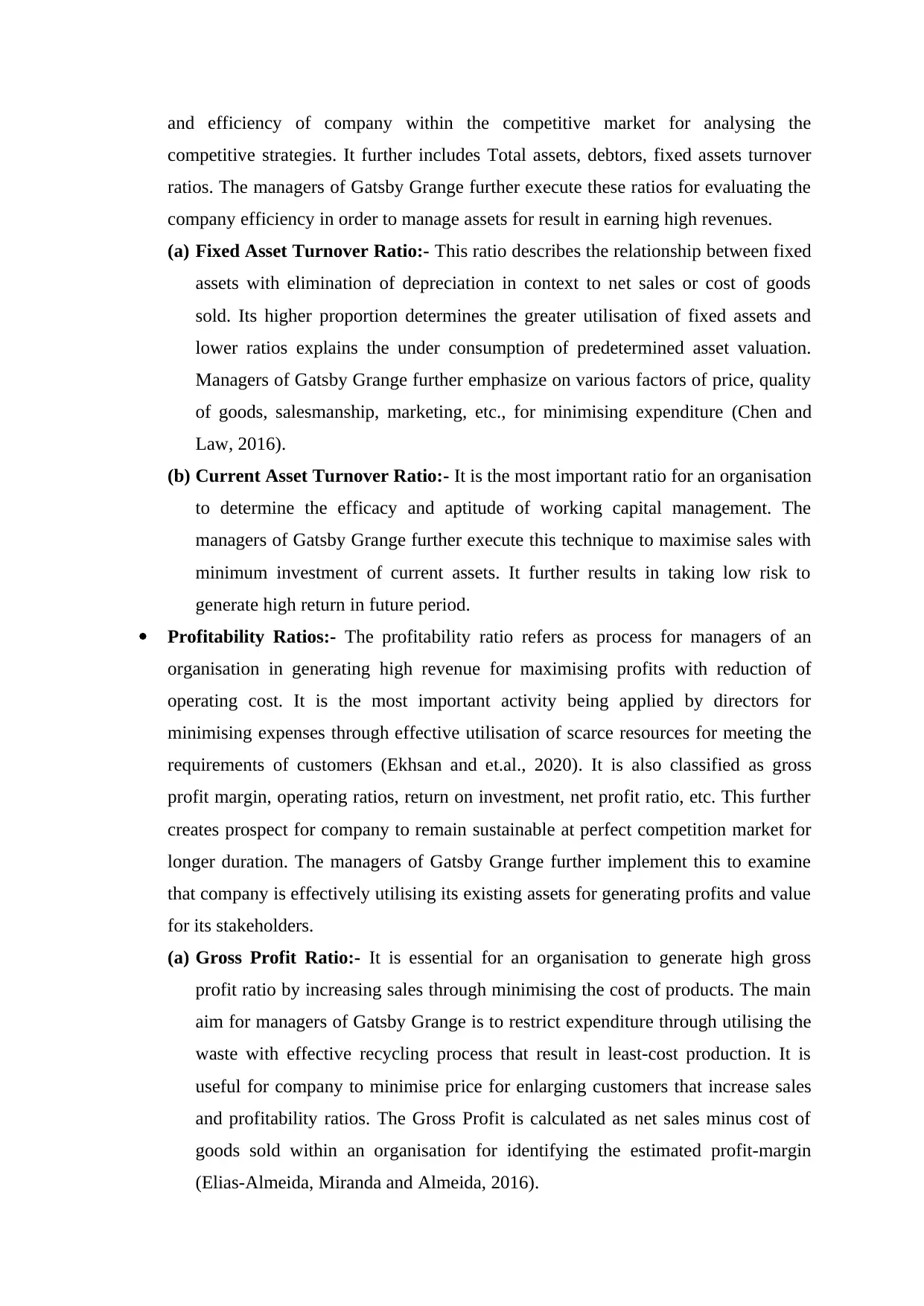
and efficiency of company within the competitive market for analysing the
competitive strategies. It further includes Total assets, debtors, fixed assets turnover
ratios. The managers of Gatsby Grange further execute these ratios for evaluating the
company efficiency in order to manage assets for result in earning high revenues.
(a) Fixed Asset Turnover Ratio:- This ratio describes the relationship between fixed
assets with elimination of depreciation in context to net sales or cost of goods
sold. Its higher proportion determines the greater utilisation of fixed assets and
lower ratios explains the under consumption of predetermined asset valuation.
Managers of Gatsby Grange further emphasize on various factors of price, quality
of goods, salesmanship, marketing, etc., for minimising expenditure (Chen and
Law, 2016).
(b) Current Asset Turnover Ratio:- It is the most important ratio for an organisation
to determine the efficacy and aptitude of working capital management. The
managers of Gatsby Grange further execute this technique to maximise sales with
minimum investment of current assets. It further results in taking low risk to
generate high return in future period.
Profitability Ratios:- The profitability ratio refers as process for managers of an
organisation in generating high revenue for maximising profits with reduction of
operating cost. It is the most important activity being applied by directors for
minimising expenses through effective utilisation of scarce resources for meeting the
requirements of customers (Ekhsan and et.al., 2020). It is also classified as gross
profit margin, operating ratios, return on investment, net profit ratio, etc. This further
creates prospect for company to remain sustainable at perfect competition market for
longer duration. The managers of Gatsby Grange further implement this to examine
that company is effectively utilising its existing assets for generating profits and value
for its stakeholders.
(a) Gross Profit Ratio:- It is essential for an organisation to generate high gross
profit ratio by increasing sales through minimising the cost of products. The main
aim for managers of Gatsby Grange is to restrict expenditure through utilising the
waste with effective recycling process that result in least-cost production. It is
useful for company to minimise price for enlarging customers that increase sales
and profitability ratios. The Gross Profit is calculated as net sales minus cost of
goods sold within an organisation for identifying the estimated profit-margin
(Elias-Almeida, Miranda and Almeida, 2016).
competitive strategies. It further includes Total assets, debtors, fixed assets turnover
ratios. The managers of Gatsby Grange further execute these ratios for evaluating the
company efficiency in order to manage assets for result in earning high revenues.
(a) Fixed Asset Turnover Ratio:- This ratio describes the relationship between fixed
assets with elimination of depreciation in context to net sales or cost of goods
sold. Its higher proportion determines the greater utilisation of fixed assets and
lower ratios explains the under consumption of predetermined asset valuation.
Managers of Gatsby Grange further emphasize on various factors of price, quality
of goods, salesmanship, marketing, etc., for minimising expenditure (Chen and
Law, 2016).
(b) Current Asset Turnover Ratio:- It is the most important ratio for an organisation
to determine the efficacy and aptitude of working capital management. The
managers of Gatsby Grange further execute this technique to maximise sales with
minimum investment of current assets. It further results in taking low risk to
generate high return in future period.
Profitability Ratios:- The profitability ratio refers as process for managers of an
organisation in generating high revenue for maximising profits with reduction of
operating cost. It is the most important activity being applied by directors for
minimising expenses through effective utilisation of scarce resources for meeting the
requirements of customers (Ekhsan and et.al., 2020). It is also classified as gross
profit margin, operating ratios, return on investment, net profit ratio, etc. This further
creates prospect for company to remain sustainable at perfect competition market for
longer duration. The managers of Gatsby Grange further implement this to examine
that company is effectively utilising its existing assets for generating profits and value
for its stakeholders.
(a) Gross Profit Ratio:- It is essential for an organisation to generate high gross
profit ratio by increasing sales through minimising the cost of products. The main
aim for managers of Gatsby Grange is to restrict expenditure through utilising the
waste with effective recycling process that result in least-cost production. It is
useful for company to minimise price for enlarging customers that increase sales
and profitability ratios. The Gross Profit is calculated as net sales minus cost of
goods sold within an organisation for identifying the estimated profit-margin
(Elias-Almeida, Miranda and Almeida, 2016).
Paraphrase This Document
Need a fresh take? Get an instant paraphrase of this document with our AI Paraphraser
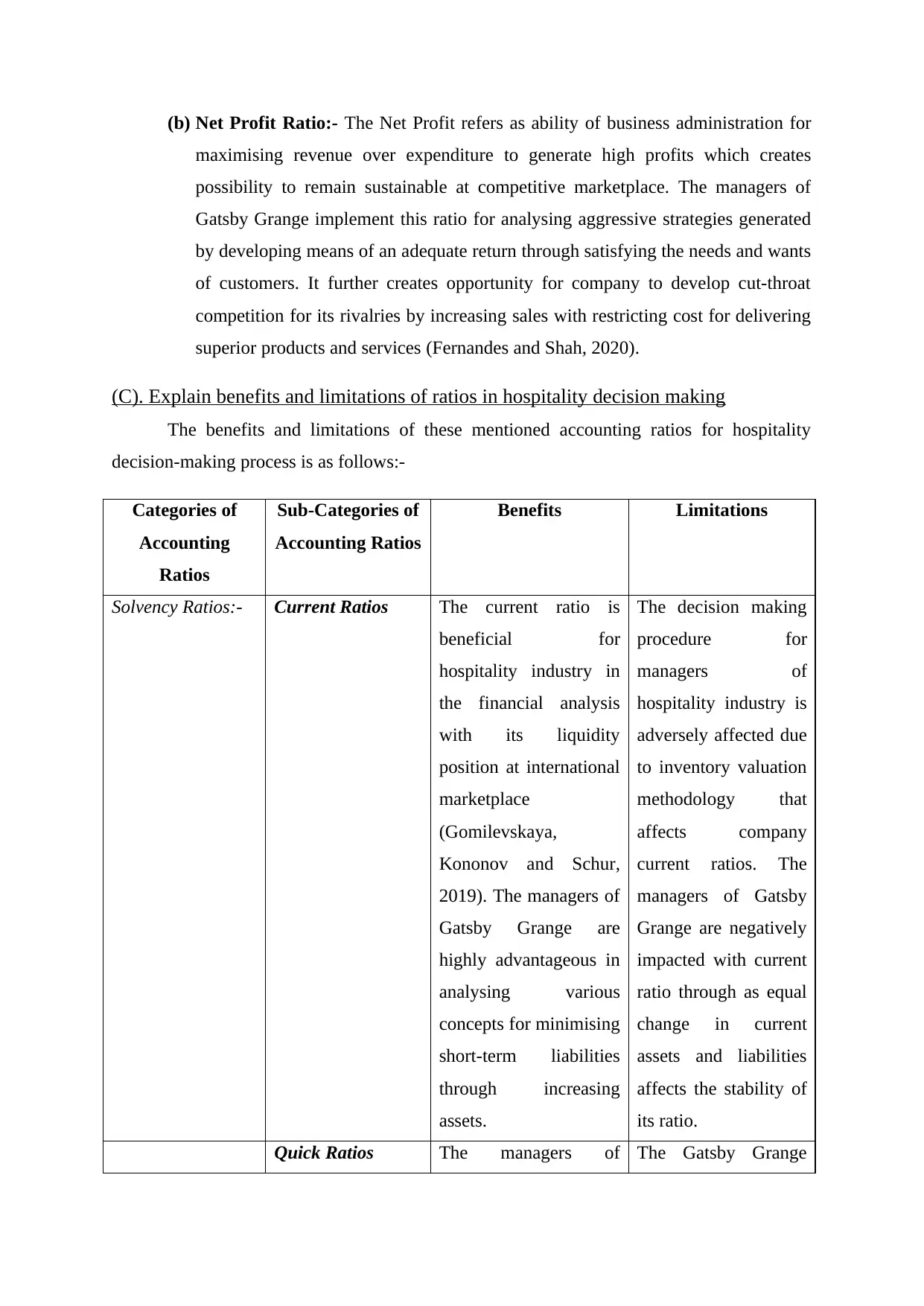
(b) Net Profit Ratio:- The Net Profit refers as ability of business administration for
maximising revenue over expenditure to generate high profits which creates
possibility to remain sustainable at competitive marketplace. The managers of
Gatsby Grange implement this ratio for analysing aggressive strategies generated
by developing means of an adequate return through satisfying the needs and wants
of customers. It further creates opportunity for company to develop cut-throat
competition for its rivalries by increasing sales with restricting cost for delivering
superior products and services (Fernandes and Shah, 2020).
(C). Explain benefits and limitations of ratios in hospitality decision making
The benefits and limitations of these mentioned accounting ratios for hospitality
decision-making process is as follows:-
Categories of
Accounting
Ratios
Sub-Categories of
Accounting Ratios
Benefits Limitations
Solvency Ratios:- Current Ratios The current ratio is
beneficial for
hospitality industry in
the financial analysis
with its liquidity
position at international
marketplace
(Gomilevskaya,
Kononov and Schur,
2019). The managers of
Gatsby Grange are
highly advantageous in
analysing various
concepts for minimising
short-term liabilities
through increasing
assets.
The decision making
procedure for
managers of
hospitality industry is
adversely affected due
to inventory valuation
methodology that
affects company
current ratios. The
managers of Gatsby
Grange are negatively
impacted with current
ratio through as equal
change in current
assets and liabilities
affects the stability of
its ratio.
Quick Ratios The managers of The Gatsby Grange
maximising revenue over expenditure to generate high profits which creates
possibility to remain sustainable at competitive marketplace. The managers of
Gatsby Grange implement this ratio for analysing aggressive strategies generated
by developing means of an adequate return through satisfying the needs and wants
of customers. It further creates opportunity for company to develop cut-throat
competition for its rivalries by increasing sales with restricting cost for delivering
superior products and services (Fernandes and Shah, 2020).
(C). Explain benefits and limitations of ratios in hospitality decision making
The benefits and limitations of these mentioned accounting ratios for hospitality
decision-making process is as follows:-
Categories of
Accounting
Ratios
Sub-Categories of
Accounting Ratios
Benefits Limitations
Solvency Ratios:- Current Ratios The current ratio is
beneficial for
hospitality industry in
the financial analysis
with its liquidity
position at international
marketplace
(Gomilevskaya,
Kononov and Schur,
2019). The managers of
Gatsby Grange are
highly advantageous in
analysing various
concepts for minimising
short-term liabilities
through increasing
assets.
The decision making
procedure for
managers of
hospitality industry is
adversely affected due
to inventory valuation
methodology that
affects company
current ratios. The
managers of Gatsby
Grange are negatively
impacted with current
ratio through as equal
change in current
assets and liabilities
affects the stability of
its ratio.
Quick Ratios The managers of The Gatsby Grange
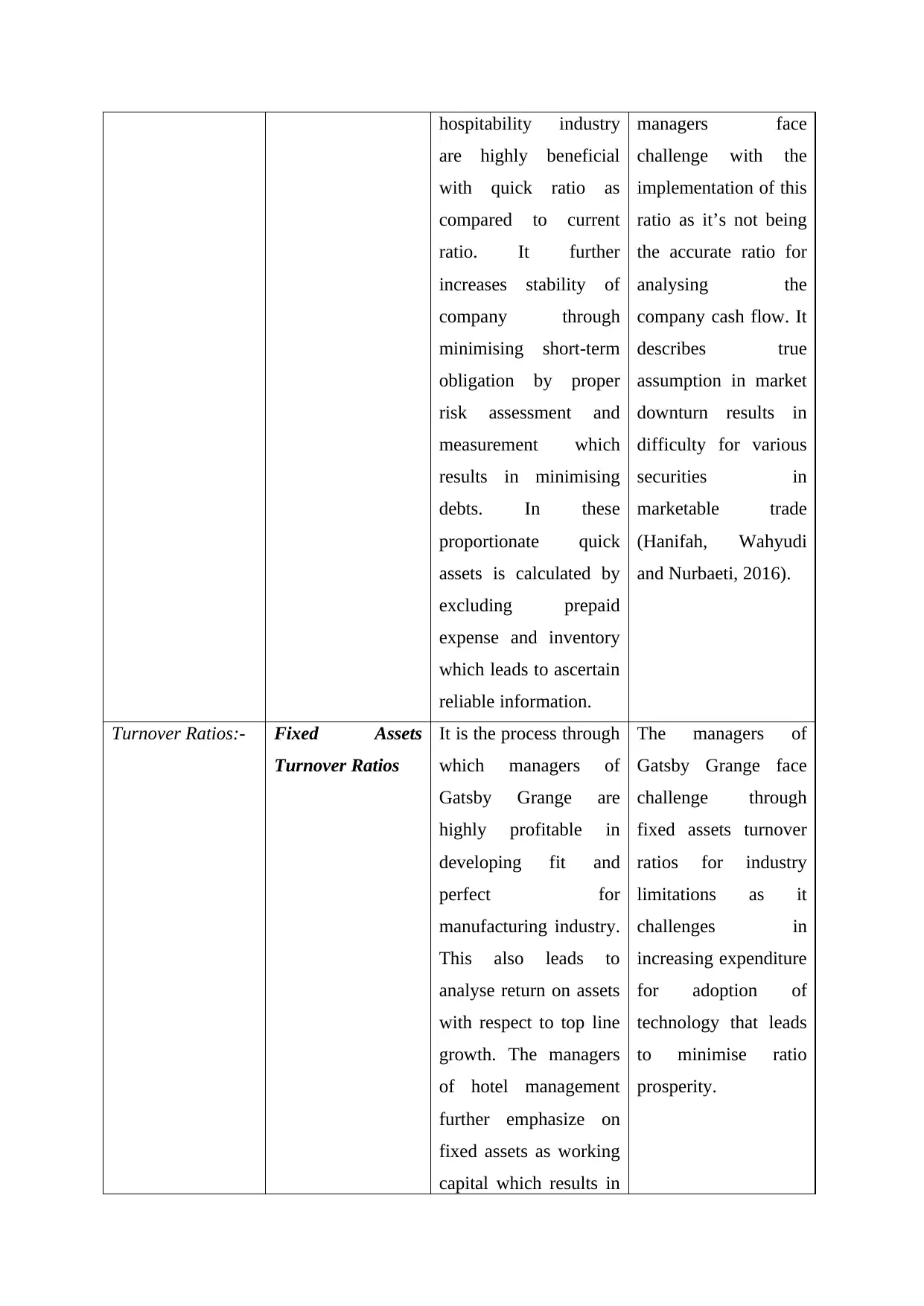
hospitability industry
are highly beneficial
with quick ratio as
compared to current
ratio. It further
increases stability of
company through
minimising short-term
obligation by proper
risk assessment and
measurement which
results in minimising
debts. In these
proportionate quick
assets is calculated by
excluding prepaid
expense and inventory
which leads to ascertain
reliable information.
managers face
challenge with the
implementation of this
ratio as it’s not being
the accurate ratio for
analysing the
company cash flow. It
describes true
assumption in market
downturn results in
difficulty for various
securities in
marketable trade
(Hanifah, Wahyudi
and Nurbaeti, 2016).
Turnover Ratios:- Fixed Assets
Turnover Ratios
It is the process through
which managers of
Gatsby Grange are
highly profitable in
developing fit and
perfect for
manufacturing industry.
This also leads to
analyse return on assets
with respect to top line
growth. The managers
of hotel management
further emphasize on
fixed assets as working
capital which results in
The managers of
Gatsby Grange face
challenge through
fixed assets turnover
ratios for industry
limitations as it
challenges in
increasing expenditure
for adoption of
technology that leads
to minimise ratio
prosperity.
are highly beneficial
with quick ratio as
compared to current
ratio. It further
increases stability of
company through
minimising short-term
obligation by proper
risk assessment and
measurement which
results in minimising
debts. In these
proportionate quick
assets is calculated by
excluding prepaid
expense and inventory
which leads to ascertain
reliable information.
managers face
challenge with the
implementation of this
ratio as it’s not being
the accurate ratio for
analysing the
company cash flow. It
describes true
assumption in market
downturn results in
difficulty for various
securities in
marketable trade
(Hanifah, Wahyudi
and Nurbaeti, 2016).
Turnover Ratios:- Fixed Assets
Turnover Ratios
It is the process through
which managers of
Gatsby Grange are
highly profitable in
developing fit and
perfect for
manufacturing industry.
This also leads to
analyse return on assets
with respect to top line
growth. The managers
of hotel management
further emphasize on
fixed assets as working
capital which results in
The managers of
Gatsby Grange face
challenge through
fixed assets turnover
ratios for industry
limitations as it
challenges in
increasing expenditure
for adoption of
technology that leads
to minimise ratio
prosperity.
⊘ This is a preview!⊘
Do you want full access?
Subscribe today to unlock all pages.

Trusted by 1+ million students worldwide
1 out of 18
Related Documents
Your All-in-One AI-Powered Toolkit for Academic Success.
+13062052269
info@desklib.com
Available 24*7 on WhatsApp / Email
![[object Object]](/_next/static/media/star-bottom.7253800d.svg)
Unlock your academic potential
Copyright © 2020–2026 A2Z Services. All Rights Reserved. Developed and managed by ZUCOL.





